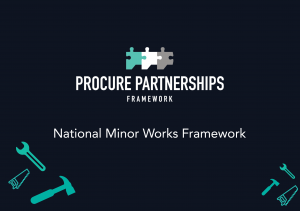With the Procurement Act 2023 (PA23) now in place, two new procedures sit at the centre of this reform: the Open Procedure and the Competitive Flexible Procedure (CFP).
Under Section 20 of PA23, a contracting authority must carry out a competitive tendering procedure that is either:
2(a) a single-stage tendering procedure without a restriction on who can submit tenders (an “open procedure”), or
2(b) such other competitive tendering procedure as the contracting authority considers appropriate for the purpose of awarding the public contract (a “competitive flexible procedure”).
Today we will be focusing on 2(b) Competitive Flexible Procedure.
Since the Act was announced, there’s been a lot of discussion about what CFP is and how it will work in practice. What are the stages? When should it be used? What are the risks compared to more established and standardised routes, like using a framework?
My name’s Tom, Key Account Manager (East), in this article, we’ll break down everything you need to know about the Competitive Flexible Procedure, explain how it fits alongside the Open Procedure, and explore both the advantages and the potentials risks.
What Is an Open Procedure?
The Open Procedure is the simplest and most traditional route to market under PA23. It’s a single-stage process that allows any interested supplier to submit a tender in response to a published notice.
Under the new legislation, buyers are no longer required to set conditions of participation (previously known as selection criteria) when using the open procedure. However, if conditions of participation are applied and a supplier fails to meet them, that supplier cannot be awarded the contract.
When procuring under the Open Procedure, buyers must observe the following minimum tendering periods:
- 25 days– where tenders are submitted electronically
- 10 days– where a qualifying planned procurement notice has been published
- 10 days– in a state of urgency where any other timescale would be impractical
The Open Procedure remains best suited for straightforward procurements where requirements are clear from the outset and where there’s limited need for negotiation or clarification during the process.
What Is a Competitive Flexible Procedure?
The Competitive Flexible Procedure is another route to market introduced under PA23, alongside the Open Procedure. It gives contracting authorities the ability to design a procurement process from start to finish that fits their project.
CFP begins with the publication of a tender notice. In this case, the notice may be used in one of two ways, either to invite suppliers to request participation in the procedure, or to submit their first (or only) tender directly.
Unlike the Open Procedure, CFP is multi-staged by design. Contracting authorities have the option to include an initial participation stage, which allows them to limit the number of suppliers taking part in the process. This can be achieved by assessing suppliers against specific conditions of participation or any other objective criteria outlined in the tender notice or supporting documents.
Once this stage is complete, the authority then has the freedom to design the remainder of the procedure to suit its project – determining how many stages to include, what level of engagement is needed, and whether to incorporate negotiation, dialogue, or demonstration phases as part of the process.
How many stages are permitted in a Competitive Flexible Procedure
Here lies one of the biggest questions surrounding the Competitive Flexible Procedure and, unfortunately, one without a single definitive answer. There is no fixed limit on the number of stages a contracting authority can include. Each process will be entirely bespoke to the project, meaning the structure, timing, and complexity of one competition could look very different from another.
What is clear, however, is that the entire design of the procedure must be set out in advance within the tender notice and supporting documents, so bidders understand exactly how the process will run from the outset. This is crucial to maintaining transparency and fairness, especially when multi-stage designs are used.
Information from Module 4: Competitive Flexible Procedure outlines typical Competitive Flexible Procedure’s might include stages such as:
- Preliminary Market Engagement (PME)
- Request to Participate / Prequalification(to shortlist suppliers)
- Invitation to Tender / First-Round Bids
- Negotiation, Dialogue, or Clarifications
- Second-Round or Final Tender
- Demonstrations, Pilots, or Site Visits
- Evaluation and Award
Contracting authorities must also decide at the outset whether they intend to include certain phases from the outset. This could include limiting the number of participants through shortlisting, or include negotiation phases later in the process – they must clearly communicate that intent in their tender documentation from the start of the tendering process.
While this level of flexibility offers clear benefits, it also introduces a degree of uncertainty. Because each procurement can be designed differently, suppliers may find it difficult to predict what to expect from one CFP to another. This variation, while intentional, can make planning, resource allocation, and bid preparation more challenging for both buyers and suppliers alike, particularly for SMEs with smaller bid resource.
What are the risks of a competitive flexible procedure
While CFP was brought in to give buyers more freedom, flexibility and to encourage innovation, it’s that same freedom that can create a degree of risk. There is a cause for concern that the CFP could reduce transparency and reduce value for money instead of enhancing it. Each of the following areas highlights where complexity, inconsistency, or risk may emerge.
Procedural Complexity
One of the most immediate risks of the Competitive Flexible Procedure lies in its complexity. By giving contracting authorities near-total freedom to design their own procurement process, the Act effectively shifts a significant administrative and legal burden onto buyers. Authorities are now responsible for defining the number of stages, their sequencing, evaluation criteria, how dialogue or negotiation will take place etc — all without the safety net of standardised templates.
While that freedom may sound empowering on paper, and perfect for innovative projects, in practice it can easily become a source of confusion and inconsistency. Each authority interpreting the rules in its own way creates uncertainty for suppliers and increases the potential for procedural errors or even non-compliance. For smaller procurement teams already working with limited resources, the absence of pre-defined processes and documentation templates adds further pressure, demanding a level of expertise and time commitment many simply don’t have.
Extended and Unpredictable Timelines
Flexibility inevitably leads to variability. We’ve mentioned CFP allows for multiple stages of negotiation and clarification, however, the length of each stage is largely at the discretion of the authority. Even with minimum time periods prescribed by the PA23, there is no statutory maximum, meaning tender periods can easily expand well beyond initial expectations. This unpredictability can lead to longer procurement cycles, increased administrative overhead, and delayed project mobilisation — undermining the very efficiency the Act aims to deliver.
Supplier Uncertainty and Access Barriers for SMEs
PA23 replaces the long-standing Most Economically Advantageous Tender (MEAT) with the Most Advantageous Tender (MAT) – a change intended to create a fairer, more balanced evaluation process. Many smaller suppliers welcomed this shift as an opportunity to compete on more than just price, with greater recognition for quality, social value, and innovation.
However, while CFP offers buyers welcome freedom, that same flexibility can become a barrier for some suppliers – particularly for SMEs. With each contracting authority now having the freedom to shape its own procurement process, suppliers are faced with a lack of consistency across tenders. Evaluation methods, timelines, and documentation can vary widely, creating uncertainty and making it harder for suppliers to anticipate what each opportunity will involve.
For smaller organisations, this lack of consistency can make it difficult to plan and prepare bids efficiently. The cost and resource involved in responding to complex, bespoke tender designs may outweigh the potential benefit, ultimately discouraging participation. Instead of levelling the playing field, the flexibility of CFP could unintentionally reduce market diversity and limit competition.
Remaining Transparent and Fair
There’s a common misconception that the Competitive Flexible Procedure allows contracting authorities to simply invite suppliers they already know or have worked with before, rather than advertising opportunities fairly to the wider market. Not only does this risk undermining the core principles of transparency and equal treatment, but it also increases the potential for challenge under the Procurement Review Unit.
Familiarity with a contractor doesn’t necessarily mean they’re the right fit for every project. Each procurement should be driven by capability, value, and alignment with project objectives – not just past relationships. Frameworks are specifically designed with lotting structures that ensure the right suppliers are competing for the right opportunities, protecting both fairness and project outcomes.
Conclusion
The Competitive Flexible Procedure was introduced with the right intentions – to make public procurement more adaptable, reduce unnecessary bureaucracy, and encourage innovation across the public sector. When used well, and supported by the right skills, knowledge, and resources, it can be an effective route to market. For some projects, particularly those that are smaller in scale or require creative solutions, CFP has the potential to streamline processes and deliver strong outcomes.
However, it’s not without risk. The flexibility that makes CFP appealing can also create inconsistency, increase administrative pressure (especially for smaller procurement teams), and reduce transparency if not managed carefully. When applied to large-scale capital projects — the kind that communities depend on — these risks are amplified. Without the right expertise and governance, the margin for error grows significantly.
For authorities managing complex or high-value projects, Procure Partnerships Frameworks call-off methods are designed to be flexible for our users, with different benefits and timescales attached to each. You can see these timescales here or if you are not sure which method best aligns with your project take our short quiz here.
Our Framework has been designed to speed up the procurement process and reduce administrative burden for public sector teams. Because the framework has already completed its full market engagement and compliance checks at the point of establishment, much of the groundwork that would otherwise slow down a competitive tender has already been done.
So, unlike when you procure through a framework, with CFP, authorities are still required to issue notices such as preliminary market engagement and pipeline notices. Authorities can therefore proceed directly to award under the framework’s terms without duplicating that early-stage market engagement step. Regarding pipeline notices the contracting authorities also don’t need to publish a pipeline notice before awarding a call off in most cases. For more information on notices check out our article Everything you need to know about the procurement act 2023
Lastly, a major challenge the public sector faces is their lack of performance tracking. Each procurement is treated as a standalone process, and once a project concludes, there’s often little access to consistent data about how that contractor has performed elsewhere.
Under part 3, chapter 5, section 52 of PA23, any public contract with an estimated value above £5 million must have at least three KPIs defined and published as part of the contract details notice. At Procure Partnerships Framework, assessing and tracking contractor performance is embedded into how our framework operates. Through our partnership with Compliance Chain, every contractor is required to report against a set of structured KPIs, covering areas such as health and safety, time management, cost management, social value delivery and more.
This data-led approach gives clients continuous visibility of a contractor’s performance and helps us inform and advise our clients more effectively. By tracking performance consistently across all projects and regions, we provide a level of transparency and accountability that the Competitive Flexible Procedure simply doesn’t offer. Public sector clients can access verified data to inform procurement choices and justifications for decisions that are clear and data-led.
Procure Partnerships Framework offers a robust, lower-risk route. You get compliant competition at speed with performance oversight and support at every stage of the tender process, from pre construction to post tender support. For more information contact me via tom@procurepartnershipsframework.co.uk or call me on 07947 888106



